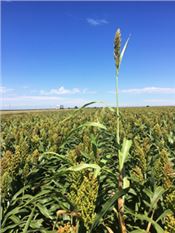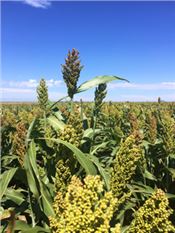|
Off-Type Sorghum Plants
BRENT BEAN
LUBBOCK, TEXAS
Nothing looks more beautiful in agriculture than a weed-free, uniform stand of grain sorghum after heading. Unfortunately, and to different degrees, sorghum fields sometimes have plants or stalks that are uneven in maturity or in height and appearance. Assuming uniform emergence, the difference in maturity often is caused by the ability of sorghum to tiller and grow additional basal stalks that produce heads later than the main stalk. This difference is largely influenced by early season environment and, to some extent, the genetics of the hybrid.
Off-type sorghum plants cause unevenness in height and plant morphology. These off-types originate from volunteer plants from seed deposited in the soil in previous years or from seed that is present in the planted seed. Off-type volunteer plants result from the segregation of characteristics in the offspring of the hybrid. If the off-types are from planted seed, they will grow as individual plants spread uniformly throughout the field in the seed rows.
The cause of these off-types in planted seed is inherent to the use of male sterile plants that do not produce pollen, which is key for producing commercial hybrids. In producing a hybrid, a male sterile parent is grown in a seed production field in a pattern of alternate rows with a male fertile parent. Pollen from the male fertile parent is transferred to the male sterile parent to produce hybrid seed that is harvested and then sold to growers. This system has proved very successful but, unfortunately, makes the male sterile plant susceptible to fertilization by foreign pollen from sorghum plants in, or in the vicinity of, the seed production field. Commercial seed production fields are isolated from other sorghum and wild species but, on occasion, foreign pollen can find its way to male sterile plants because sorghum pollen can move several miles by wind. The resulting seed looks identical to the desired hybrid seed and thus can end up in the bag of seed planted by the grower.

In addition to isolation, seed companies use split plantings of male fertile parents to ensure a significant pollen load when the male sterile plants are in bloom. Split plantings are most often three different planting dates of the male fertile parent. By having multiple planting dates of the male fertile parent, synchronization of bloom between male sterile and male fertile plants ensures a good load of pollen within the seed field, limiting the possibility that foreign pollen will pollinate male sterile plants.
Off-type sorghums can be divided into five distinct groups:
• Tall mutants. As the name implies, these plants are 1 foot to 3 feet taller than normal plants and are the most common off-types. However, other than the height difference, they are identical to the normal plants. Three genes affect height. The tall off-type is a result of one of the genes becoming unstable. Parent genotypes will vary in their frequency in producing tall off-types. With the use of genetic markers and other modern techniques, seed companies can greatly reduce the frequency of tall mutants. However, since these tall mutants have no effect on yield, some seed companies place more emphasis on this characteristic than others.
• Grain outcross or off-color panicles. These plants are usually similar in height to the desired hybrid but may have very different seed color or panicle shape. These off-type plants are a result of foreign pollen, which is usually from grain sorghum that contaminates the seed production field.
• Forage types or grain forage. This group exhibits characteristics associated with forage sorghum, meaning that the plants are normally tall and single stalked with a typical grain sorghum-type panicle. These plants originate from the pollen of forage sorghum typically used for silage.
• Open head forage, grassy sorghum or shattercane. This group results from pollen of sudangrass or sorghum-sudangrass hybrids in or near the seed production field. Plants can vary greatly in height and plant appearance and typically produce numerous tillers. The panicles are more grasslike, in that they are loose and open.
• Johnsongrass outcross. These plants occur when Johnsongrass pollinates the male sterile plants in the production field. This type of cross-pollination does not occur often due to the genetic incompatibility between Johnsongrass and grain sorghum. When it does occur, the resulting plants have rhizomes but seldom produce any viable seed. Plants are typically Johnsongrass-like in appearance with slender stalks, many tillers and an open panicle. ∆
BRENT BEAN: USCP Agronomist

Grain Forage

Tall Mutant
|
|